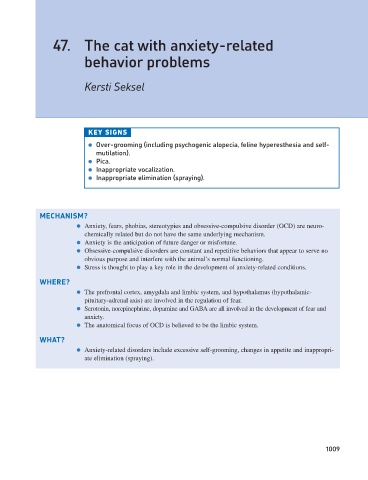Page 1017 - Problem-Based Feline Medicine
P. 1017
47. The cat with anxiety-related
behavior problems
Kersti Seksel
KEY SIGNS
● Over-grooming (including psychogenic alopecia, feline hyperesthesia and self-
mutilation).
● Pica.
● Inappropriate vocalization.
● Inappropriate elimination (spraying).
MECHANISM?
● Anxiety, fears, phobias, stereotypies and obsessive-compulsive disorder (OCD) are neuro-
chemically related but do not have the same underlying mechanism.
● Anxiety is the anticipation of future danger or misfortune.
● Obsessive-compulsive disorders are constant and repetitive behaviors that appear to serve no
obvious purpose and interfere with the animal’s normal functioning.
● Stress is thought to play a key role in the development of anxiety-related conditions.
WHERE?
● The prefrontal cortex, amygdala and limbic system, and hypothalamus (hypothalamic-
pituitary-adrenal axis) are involved in the regulation of fear.
● Serotonin, norepinephrine, dopamine and GABA are all involved in the development of fear and
anxiety.
● The anatomical focus of OCD is believed to be the limbic system.
WHAT?
● Anxiety-related disorders include excessive self-grooming, changes in appetite and inappropri-
ate elimination (spraying).
1009

